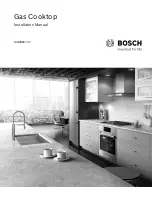
13
Safety and Energy saving advice
- The diameter of the bottom of the pan should correspond to that of the burner.
BURNERS
PANS
Φ min.
Φ max.
Rapid
200mm
260mm
Semi-Rapid
130mm
180mm
Auxiliary
100mm
120mm
NO
YES
Do not use small diameter cookware on
large burners.
The flame should never come up the
sides of the cookware.
Always use cookware that are
suitable for each burner, so as
to avoid wasting gas and
discolouring the cookware.
Never cook without a lid or with the lid
half off
- you are wasting energy.
Always place the lid on the
cookware.
Do not use a pan with a convex or
concave bottom.
Only use pots, saucepans and
frying pans with thick, flat
bottom.
Do not place cookware on one side of a
burner, as if could tip over. Do not use
cookware with a large diameter on the
burners near the controls, which when
placed on the middle of the burner may
touch the controls or be so close to them
that they increase the temperature in this
area and may cause damage.
Always place the cookware
right over the burners, not to
one side.
Never place cookware directly on top of
the burner.
Place the cookware on top of
the pan support.
Do not use excessive weight and do not
hit the hob with heavy objects.
Handle cookware carefully
when they are on the burner.
■ It is not permitted to use roasting pans, frying pans or grill stones heated
simultaneously by several burners because the resulting heat build-up
may damage the appliance.
■ Do not touch the hob top and pan support while using or for a certain
period after using.
■ As soon as a liquid starts boiling, turn down the flame so that it will
barely keep the liquid simmering.
■ User can’t use cooking pan
on the hotplate that overlap
its edge.
14
■ Take off the pan supports.
■ Clean these and the control handles with a damp cloth, washing up liquid and warm
water. Stubborn soiling is best soaked before.
■ Finally dry everything with a clean soft cloth.
Cleaning and Maintenance
■ Cleaning operations must only be carried out when the appliance is cool.
■ The appliance should be disconnected from your mains supply before
commencing any cleaning process.
■ Clean the appliance regularly, preferably after each use.
■ Abrasive cleaners or sharp objects will damage the appliance
surface;you should clean it using water and a little washing up liquid.
Pan support, Control handles
■ Regularly wipe over the top plate using a soft cloth well wrung out in warm water to
which a little washing up liquid has been added.
■ Dry the top plate thoroughly after cleaning.
■ Thoroughly remove salty foods or liquids from the hob as soon as possible to avoid
the risk of corrosion.
■ Stainless steel parts of the appliance may become discoloured over time. This is
normal because of the high temperatures. Each time the appliance is used these
parts should be cleaned with a product that is suitable for stainless steel.
Top plate
Usable
Unusable
Soft Clothing
Sponge Brush
neutral Detergent
Nylon Brush
Edible Oil
Abrasive
Metal Brush
Acidic/Alkali
Detergent
Thinner/Benzene
Soft Clothing
Soft Clothing
Sponge Brush
neutral Detergent
Nylon Brush
Edible Oil
Abrasive
Metal Brush
Acidic/Alkali
Detergent
Thinner/Benzene
Nylon Brush
Metal Brush
Soft Clothing
Sponge Brush
neutral Detergent
Nylon Brush
Edible Oil
Abrasive
Metal Brush
Acidic/Alkali
Detergent
Thinner/Benzene
Sponge Brush
Soft Clothing
Sponge Brush
neutral Detergent
Nylon Brush
Edible Oil
Abrasive
Metal Brush
Acidic/Alkali
Detergent
Thinner/Benzene
Edible Oil
Acidic/Alkali
Detergent
Soft Clothing
Sponge Brush
neutral Detergent
Nylon Brush
Edible Oil
Abrasive
Metal Brush
Acidic/Alkali
Detergent
Thinner/Benzene
Neutral Detergent
Soft Clothing
Sponge Brush
neutral Detergent
Nylon Brush
Edible Oil
Abrasive
Metal Brush
Acidic/Alkali
Detergent
Thinner/Benzene
Abrasive
Thinner/Benzene
Nylon Brush
Thinner/Benzene
Metal Brush
Abrasive
Soft Clothing
Sponge Brush
Neutral Detergent
































